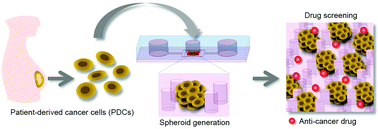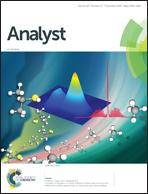Formation of size-controllable tumour spheroids using a microfluidic pillar array (μFPA) device
Abstract
Spheroids are recognized for replicating the physiological microenvironment of tumours. However, because of the lack of controllability of the spheroid size, the response to anticancer drugs is variable in conventional spheroid culture methods. In this paper, we describe a method to generate several hundreds of spheroids of various types of cancer cells including patient derived cancer cells (PDCs) using a microfluidic device with pillars (diameter: 40 μm, height: 70 μm, center-to-center distance: 140 μm), called a microfluidic pillar array (μFPA) device. About three hundred glioma (U87) spheroids were obtained in the μFPA device within 3 days, and about 90% of them ranged from 175 to 225 μm. These spheroids were more resistant to doxorubicin at 10 μM than U87 cells in a monolayer. The former showed higher expression of CD133, a cancer stem cell marker, than the latter. Hypoxia inducible factor-1α (HIF-1α), another cancer stem cell marker, was found in the nucleus of the former, but found in the cytoplasm of the cells in a monolayer. Drug responses of spheroids of another glioma cell line (U251) and triple negative breast cancer (TNBC) primary cells were also easily quantified by measuring changes in spheroid size at different concentrations of their respective drug on the μFPA device. The μFPA device can be a powerful platform for obtaining uniform spheroids and monitoring the drug response of cancer cells including PDCs.



 Please wait while we load your content...
Please wait while we load your content...